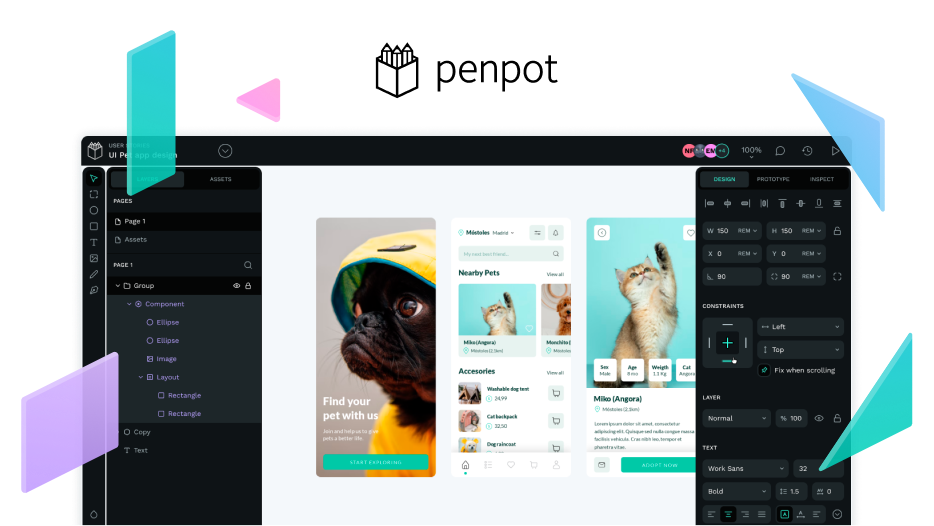We recently came across this neat Penpot dashboard by the folks at OSSInsight. Here is the explicit link: https://ossinsight.io/analyze/penpot/penpot
The Github stars vanity metric continues to fascinate us. In the past we were able to explain some of the “peaks” but we’re unsure we have any “control” over them anymore.
We know that we belong to the “club of the > 10K stars”, which represents less than a tiny fraction of a tiny fraction of all Github repositories, cool! For an extreme comparison, the Go programming language has a bit more than 100K stars, and it surely deserves more than just ten times the love for Penpot, so clearly Github stars doesn’t grow linearly with “impact” and yet we can still infer some interesting facts about these stargazers.
Before I go into some relevant questions, let’s see the geographical distribution of these stars.
All the usual suspects are there but there are three quick takeaways. 1) USA > China (that’s not the case for Golang and many other big repos). 2) Spain is on top 10 probably because the core team resides in this European country. 3) Indonesia doesn’t typically belong to the top 10 stargazing countries (and Penpot is roughly only 5% translated into Indonesian). So what can I say? Hi Indonesia! We love you!!!
The USA/China board leadership is consistent with the top stargazing companies. On USA we have Microsoft, Google, Redhat and Thoughtworks. From China, Tencent, bytedance, Alibaba and Baidu. Regarding Tencent (#1 stargazing company), we know they were planning to develop a massive plugin framework to connect design and prototyping tools with developer pipelines… until they found Penpot, which allows them to focus on one design and prototyping tool and develop extensions and plugins around that idea. Easier and with all the open source perks!
Now, Github, despite their claim that they want Git to be accessible to non-developers, it’s basically 99% devs around the world. At the same time, Penpot is currently more attractive to designers than to developers. So, what are those developers telling us with their “stars”?
Hypothesis 1, they’re Clojure/Clojurescript fans
Penpot is a great example of what you can do with Clojure and Clojurescript and we have strong reasons to pick this technology. You can read Andrey’s article on this on our Kaleidos blog.
So you could argue that a lot of Clojure devs are “fav-ing” the repo as a way to show love and learn a few tricks. Now, Penpot has more stars than Clojure and Clojurescript Github repos so this doesn’t hold up easily even if we know these two Clojure repos don’t follow classical Github activity flows.
Hypothesis 2, they’re sysadmins looking for self-hosting open source alternatives to proprietary design tools
This would be consistent with what we know about Taiga fanbase. It makes a lot of sense. Even if Penpot is labelled BETA due to its feature-incompletedness, you could expect that it’s already providing a ton of value for teams and organisations that need a professional design and prototyping tool that can be deployed locally. We have thousands of active Penpot instances out there already so there could be a clear correlation between both metrics.
Hypothesis 3, they’re developers in the need for a design tool they can enjoy
Perhaps frontend developers too close to design and prototyping tools to suffer from an unwelcoming experience with the current status quo?
Hypothesis 4, it’s just showing growing awareness from the developer community
It could be as simple as this. People are discovering Penpot trough word of mouth, tech articles or social media and they’re just showing support but there’s no “winning” group.
What I do think these stars represent is “early adopters love” (even if they look like a ton of people already), so I think it’d be supervalid to perform some research on these 10k+ stargazers now and compare it with stargazers in 2024 or something like that. Would you recommend us any specific “insight tool” to break down this data? There are quite a few available! Any wild guesses from you regarding this statistical info?
On a side topic, the OSSInsight dashboard show extremely consistent pull request waiting times. 75% of all pull requests are merged within 20h, which sounds like a “working day” to me. This has to do more with internal team dynamics but it’s an interesting metric nonetheless. I wonder how that will evolve over time as we are joined by more community code contributors.



